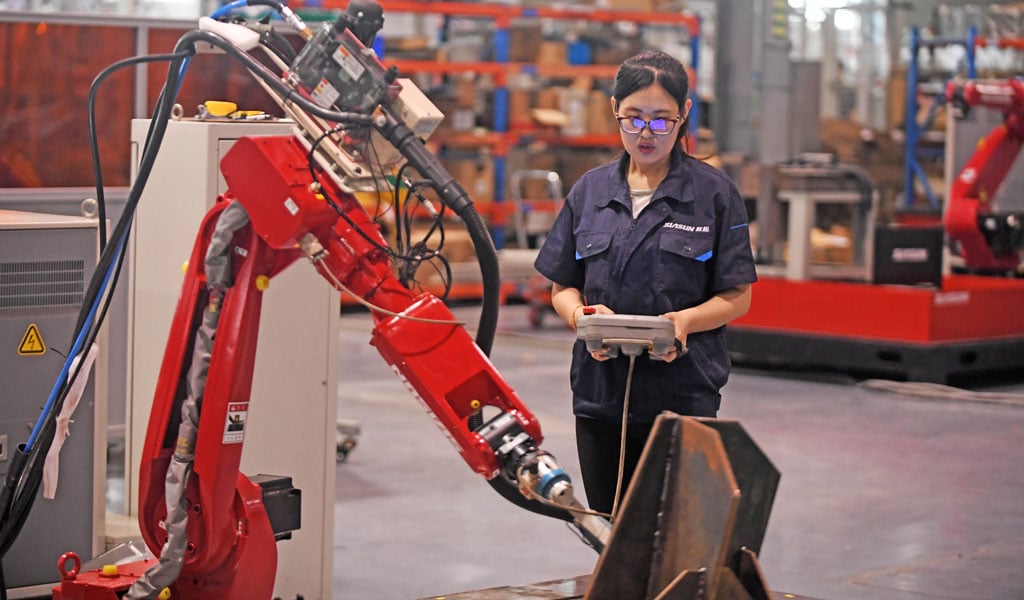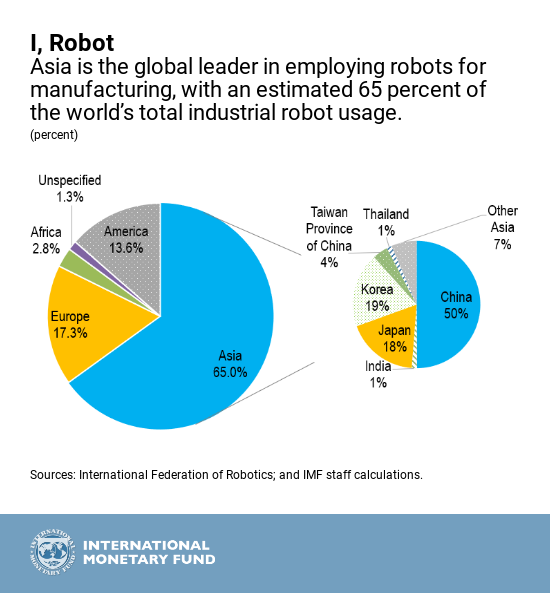With about 1 million robots in use in Asia, robotics and automation mean economic risks and growth opportunities for the region. For Asia to fully reap this digital opportunity as the world’s main engine of growth, countries need to revamp their education systems and invest in innovation to support a workforce for humans and robots alike.
As digital technologies like artificial intelligence transform business models, the rise of industrial robot usage—robotics used for manufacturing, for example in welding—in Asia signals a change is underway.
As our chart of the week from the last Regional Economic Outlook: Asia Pacific shows, Asia is at the forefront of automation with an estimated 65 percent of the world’s total industrial robot usage for 2017. In Asia, China is now the single biggest user of these robots with an estimated 50 percent of the region’s total industrial robot usage, followed by Korea and Japan.
It comes as no surprise then that Asia, with all these robots, has the highest robot density, which is the number of industrial robots per 10,000 workers. Korea and Singapore are global leaders in robot density, followed by Germany and Japan.
Further, Asia may be the global leader in employing industrial robots, but it is also the region with the highest robot production—Japan and Korea are the world’s top two producers, with market shares of 52 and 12 percent, respectively.
Robot takeover
With more than half of the world’s estimated stock of industrial robots in use, Asia’s investments in robotics show how crucial the automation of production is for the region’s economies.
Yet, automation and digitalization are not new. Recent advances in computing power and powerful data generation equip robotics with more cognitive capability, such as the latest generation of robots that can collect data to adapt their movements in real time. This means that more complex work that could only be done by humans can now be done by machines.
This trend could mean trouble for workers in Asia where relatively low-cost and low-skilled labor has been the basis for the region’s role as “the factory to the world.” More robots than humans doing technical work may bring down the cost of business, including labor costs, significantly. As a result, workers are displaced as producers are more likely to employ robots that cost less and perform more effectively, rather than having to pay wages.
Digital divide vs. digital dividend
The movement towards more automation and digitalization may bring global economic challenges, but it also provides opportunities for Asia to bolster its economy and reap the digital dividend—the economic benefits that come from going digital.
To maintain its global competitiveness and to keep the world’s main engine of growth running, Asia’s policymakers need to tackle disruptions caused by automation and robots by supporting job creation without stifling innovation. This fine balance is easier said than done, but policies that can help include:
- Equipping job seekers with globally competitive skillsets by revamping education
- Investing in physical and regulatory infrastructure that supports entrepreneurship, innovation, and competition; and
- Addressing labor-market and social challenges, including income redistribution and safety nets.
Stay tuned for more details on policies to accomplish this shift in the upcoming October 2018 Regional Economic Outlook: Asia Pacific. The report focuses on the digital economy and the economic impact of digitalization and automation developments in Asia, and policies to reap digital dividends.





